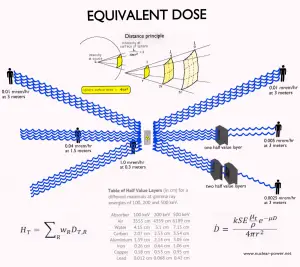 In radiation protection, the rem (an abbreviation for Roentgen Equivalent Man) is the non-SI unit of the equivalent dose, which is used predominantly in the USA. The rem represents the equivalent biological effect of the deposit of one hundred ergs (one rad) of gamma rays energy in a kilogram of human tissue. The rem is not derived from the unit of exposure, the roentgen. The acronym is now a misleading historical artifact, since 1 roentgen actually deposits about 0.96 rem in soft biological tissue, when all weighting factors equal unity.
In radiation protection, the rem (an abbreviation for Roentgen Equivalent Man) is the non-SI unit of the equivalent dose, which is used predominantly in the USA. The rem represents the equivalent biological effect of the deposit of one hundred ergs (one rad) of gamma rays energy in a kilogram of human tissue. The rem is not derived from the unit of exposure, the roentgen. The acronym is now a misleading historical artifact, since 1 roentgen actually deposits about 0.96 rem in soft biological tissue, when all weighting factors equal unity.
As was written, the rem is used for radiation dose quantities such as equivalent dose and effective dose. Equivalent dose (symbol HT) is a dose quantity calculated for individual organs (index T – tissue). Equivalent dose is based on the absorbed dose to an organ, adjusted to account for the effectiveness of the type of radiation. The SI unit of HT is the sievert (Sv) or but rem (roentgen equivalent man) is still commonly used (1 Sv = 100 rem).
One rem is also a large amount of equivalent dose. A person who has absorbed a whole body dose of 1 rem has absorbed one hundred ergs of energy in each kg of body tissue (in case of gamma rays).
Equivalent doses measured in industry and medicine often have usually lower doses than one rem, and the following multiples are often used:
1 mrem (millirem) = 1E-3 rem
1 krem (kilorem) = 1E3 rem
Conversions from the SI units to other units are as follows:
- 1 Sv = 100 rem
- 1 mSv = 100 mrem
Examples of Doses in millirems
We must note that radiation is all around us. In, around, and above the world we live in. It is a natural energy force that surrounds us. It is a part of our natural world that has been here since the birth of our planet. In the following points we try to express enormous ranges of radiation exposure, which can be obtained from various sources.
- 0.005 mrem – Sleeping next to someone
- 0.009 mrem – Living within 30 miles of a nuclear power plant for a year
- 0.01 mrem – Eating one banana
- 0.03 mrem – Living within 50 miles of a coal power plant for a year
- 1 mrem – Average daily dose received from natural background
- 2 mrem – Chest X-ray
- 4 mrem – A 5-hour airplane flight
- 60 mrem – mammogram
- 100 mrem – Dose limit for individual members of the public, total effective dose per annum
- 365 mrem – Average yearly dose received from natural background
- 580 mrem – Chest CT scan
- 1 000 mrem – Average yearly dose received from natural background in Ramsar, Iran
- 2 000 mrem – single full-body CT scan
- 17 500 mrem – Annual dose from natural radiation on a monazite beach near Guarapari, Brazil.
- 500 000 mrem – Dose that kills a human with a 50% risk within 30 days (LD50/30), if the dose is received over a very short duration.
We hope, this article, millirem – kilorem – multiples of rem, helps you. If so, give us a like in the sidebar. Main purpose of this website is to help the public to learn some interesting and important information about radiation and dosimeters.